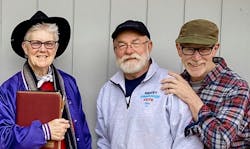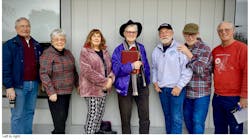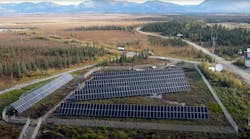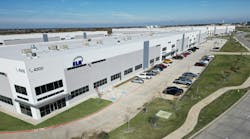Ken Smith, chair of the Oakmont Energy Resiliency Project, has invested 900 volunteer hours into an effort to create a community microgrid for his senior community on the eastern side of fire-prone Santa Rosa, California, and the project has reached an important milestone. The community, the Oakmont Village Association, was selected as a test site for a mobile energy backup system powered by hydrogen fuel cells.
In January, the Electric Power Research Institute and the California Energy Commission chose the community to test the technology – a mobile generator with a peak output of 65 kW. The test will begin in the fall, and the mobile generator will cost nothing for the Oakmont community for 18 months – the duration of the test, said Smith.
The mobile backup system is produced by Renewable Innovations, which makes mobile hydrogen fuel cell generators that are coupled with battery energy storage. The technology is built into a towable trailer. It will connect to the electric service at the community’s central complex, or the largest of three community centers, where the unit could be used to charge phones and medical equipment as well as provide heating or cooling for residents during outages, said Smith.
Oakmont Village Association, which includes 1,800 acres, 3,204 homes, 24 businesses and a fire station, wants to install a microgrid consisting of rooftop photovoltaics (PV), a ground mount “solar farm” with solar tracker PV units and a commercial or community energy storage system, possibly with aggregated residential batteries, said Smith.
In addition to being chosen for the test, the Oakmont community has achieved its goal of offsetting 90% to 95% of its energy use at its community centers, thanks to parking lot canopy solar PV systems. The PV carport systems became operational during the second quarter of 2021 and were financed through a 25-year power purchase agreement.
Next steps
The plan now is to add rooftop solar on homes. Smith wants to identify homes with southern exposure and double the number of panels needed for each of those homes so that other houses can use the solar. Smith expects that about 1,500 homes could participate in the project. The community could create its own community choice aggregation (CCA) to sell the power to residents, or it could try to sell it to the Sonoma Clean Power CCA.
In spite of the recent gains, the Oakmont project faces numerous challenges, including finding funding and a contractor and dealing with policies that are in flux.
The group’s struggles can inform others trying to establish community microgrids, said Smith.
For Oakmont Village Association, the microgrid would provide much needed resiliency. The community is located in Sonoma Valley between the Mayacamas Mountains and Trione-Annadel State Park, in Tier 3 and Tier 2 high-risk fire zones.
Since 2019, the residents – whose average age is 75 – have endured 22 outages and public safety power shutoffs (PSPS). During the PSPS events, utility Pacific Gas & Electric (PG&E) shuts off power to avoid fires sparked by electrical equipment.
The outages – the longest of which was six days – threaten the health and safety of about 20% of the 4,700 residents who have mobility challenges and need electricity to operate medical devices, Smith said.
Pacific Palisades microgrid draws participants
Meanwhile, another community microgrid project planned for Pacific Palisades, California, is moving forward under the direction of Resilient Palisades, a nonprofit group. Like the Oakmont project, Resilient Palisades aims to provide resiliency in an area plagued by power outages.
“Phase I has been an unqualified success. We’ve had 40 Palisadian households sign up for rooftop solar and 30 successful installs to date,” said Ryan Craig, co-lead of the clean energy team at Resilient Palisades.
Under Phase II, the group will work to deploy a microgrid. But it will only be possible once the Los Angeles Department of Water and Power (LADWP) determines that the community has enough solar and storage density in the neighborhood, said Craig.
LADWP issued a request for proposals for distributed energy resources in the community, has received proposals and is actively considering a virtual power plant (VPP), Craig said. The community is taking its cues from the utility, waiting for a decision on the VPP, he added.
In Oakmont, PG&E is working with the seniors to help deploy a microgrid. In December 2021, PG&E accepted the community into its Community Microgrid Enablement Program (CMEP), a program that aims to move community microgrids forward.
PG&E has a total budget of $82.2 million for CMEP. The program provides cost offsets for certain distribution system upgrades and technical support for creating resilience for critical facilities during extreme weather or PSPS.
The Oakmont community is limited by how much distribution is available from PG&E. An engineer for PG&E told the group that the system could handle 6 MW to 8 MW of power.
If the Oakmont group forms a CCA, it would have to pay PG&E for the use of its distribution system, said Smith.
Getting community buy-in
Moving forward will require getting the buy-in of community residents, finding funding sources and gaining help from outsiders, said Smith.
Smith wants to conduct a survey to find out how residents feel about forming a CCA and is also planning an outreach campaign to educate and gather support from Oakmont members and businesses within the community’s boundary.
Creating a CCA is not in the community’s charter, so the Oakmont Energy Resiliency Project would have to hire a third party to create and run the CCA. To date, the group has not found a company to fill that role.
“The Oakmont Village Association has no interest in being an administrator or trying to fund the effort. That requires too much legal activity, which would raise dues,” said Smith.
Funding is also an issue. The village association is open to an energy-as-a-service contract, under which it wouldn’t make upfront capital investments. In the meantime, the community has to conduct an interconnection study and has not yet identified how it will pay for that.
The Oakmont Energy Resiliency Project had applied for a $550,000 grant from the California Office of Emergency Services and that could possibly pay for the study, said Smith.
Hang in there
Policy surrounding renewable energy and microgrids in California is changing right now, but it could ultimately benefit the seniors’ effort.
The California Public Utilities Commission, through SB 1339, has created new rules that are scheduled to be implemented early this year, and they should expedite the creation of microgrids and distributed energy resources. In addition, new tariff changes may allow or create ratepayer and energy credit allowances that help monetize energy storage and distributed energy resources, said Smith.
In spite of the fact that much work needs to be done, Smith’s group has plowed a lot of ground, he said.
Smith’s advice to other communities seeking to deploy community microgrids: “You need to look at all the resources you can think of. Hang in there. It’s a tedious process.”
Interested in learning more about the community microgrids? Join us May 16-17 in Anaheim, California for Microgrid Knowledge 2023: Lights On!









